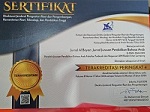Zoom-Based Arabic Learning During and Post Covid-19
Abstract
Keywords
Full Text:
PDFReferences
Abdullayev, Abdukayum Abdulkhayevich. “System of Information and Communication Technologies in the Education.” Science and World International Scientific Journal 2 (2020): 19–21.
Adas, Dana, and Ayda Bakir. “Writing Difficulties and New Solutions: Blended Learning as an Approach to Improve Writing Abilities.” International Journal of Humanities and Social Science 3, no. 9 (2013): 254–66.
Amzaleg, Meital, and Asmahan Masry-Herzallah. “Cultural Dimensions and Skills in the 21 St Century: The Israeli Education System as a Case Study.” Pedagogy, Culture & Society 30, no. 5 (October 20, 2022): 765–85. https://doi.org/10.1080/14681366.2021.1873170.
Anhusadar, Laode. “Persepsi Mahasiswa PIAUD Terhadap Kuliah Online Di Masa Pandemi Covid 19.” Kindergarten: Journal of Islamic Early Childhood Education 3, no. 1 (April 29, 2020): 44. https://doi.org/10.24014/kjiece.v3i1.9609.
Arlianti, Nofyta, Mira Hastin, Ali Ramatni, Loria Wahyuni, and Nelvia Susmita. “Effectiveness of Learning Using Application Zoom Theon Student Learning Outcomes during COVID-19 at STKIP Muhammadiyah Sungai Penuh.” Linguistics and Culture Review 6 (February 10, 2022): 308–19. https://doi.org/10.21744/lingcure.v6nS3.2163.
Bawanti, Putri Karya Dwi, and Yudhi Arifani. “The Students’ Perceptions of Using Zoom Application on Mobile Phone in Improving Speaking Skills During Online Learning at Ban Loeiwangsai School, Loei Province, Thailand.” Journal of English Teaching, Literature, and Applied Linguistics 5, no. 1 (March 10, 2021): 54. https://doi.org/10.30587/jetlal.v5i1.2212.
Caruso, Loris. “Digital Innovation and the Fourth Industrial Revolution: Epochal Social Changes?” Ai & Society 33, no. 3 (August 24, 2018): 379–92. https://doi.org/10.1007/s00146-017-0736-1.
Fajri, Zaenol, Hasan Baharun, Chusnul Muali, Lilik Farida, Yulis Wahyuningtiyas, and others. “Student’s Learning Motivation and Interest; The Effectiveness of Online Learning during COVID-19 Pandemic.” Journal of Physics: Conference Series, 1899 (2021).
Haqien, Danin, and Aqiilah Afiifadiyah Rahman. “Pemanfaatan Zoom Meeting Untuk Proses Pembelajaran Pada Masa Pandemi Covid-19.” SAP (Susunan Artikel Pendidikan) 5, no. 1 (August 4, 2020). https://doi.org/10.30998/sap.v5i1.6511.
Jannah, Miftahul, Jimmi Copriady, and Rasmiwetti Rasmiwetti. “Development of Interactive Learning Media Using Autoplay Media Studio 8 for Colloidal Chemistry Material.” Journal Of Educational Sciences 3, no. 1 (February 15, 2019): 132. https://doi.org/10.31258/jes.3.1.p.132-144.
Kabudi, Tumaini, Ilias Pappas, and Dag Håkon Olsen. “AI-Enabled Adaptive Learning Systems: A Systematic Mapping of the Literature.” Computers and Education: Artificial Intelligence 2 (2021): 100017. https://doi.org/10.1016/j.caeai.2021.100017.
Khasanah, Siti Uswatun, and Ainun Syarifah. “Persepsi Mahasiswa Pendidikan Bahasa Inggris UIN Sunan Ampel Surabaya Terhadap Pembelajaran Daring Via Zoom Pada Masa Pandemi Covid-19.” Edunesia : Jurnal Ilmiah Pendidikan 2, no. 1 (January 1, 2021): 23–33. https://doi.org/10.51276/edu.v2i1.70.
Monica, Junita, and Dini Fitriawati. “Efektivitas Penggunaan Aplikasi Zoom Sebagai Media Pembelajaran Online Pada Mahasiswa Saat Pandemi Covid-19.” Jurnal Communio : Jurnal Jurusan Ilmu Komunikasi 9, no. 2 (November 8, 2020): 1630–40. https://doi.org/10.35508/jikom.v9i2.2416.
Moore, Joi L, Camille Dickson-Deane, and Krista Galyen. “E-Learning, Online Learning, and Distance Learning Environments: Are They the Same?” The Internet and Higher Education 14, no. 2 (March 2011): 129–35. https://doi.org/10.1016/j.iheduc.2010.10.001.
Motiwalla, Luvai, and Steven Tello. “Distance Learning on the Internet: An Exploratory Study.” The Internet and Higher Education 2, no. 4 (December 2000): 253–64. https://doi.org/10.1016/S1096-7516(00)00026-9.
Nadezhda, Guzachchova. “Zoom Technology as an Effective Tool for Distance Learning in Teaching English to Medical Students.” Бюллетень Науки и Практики 6, no. 5 (2020): 457–60.
Nassif, Ali Bou, Ashraf Elnagar, Ismail Shahin, and Safaa Henno. “Deep Learning for Arabic Subjective Sentiment Analysis: Challenges and Research Opportunities.” Applied Soft Computing 98 (January 2021): 106836. https://doi.org/10.1016/j.asoc.2020.106836.
Nurdin, Nurdin, and Laode Anhusadar. “Efektivitas Pembelajaran Online Pendidik PAUD Di Tengah Pandemi Covid 19.” Jurnal Obsesi : Jurnal Pendidikan Anak Usia Dini 5, no. 1 (August 10, 2020): 686. https://doi.org/10.31004/obsesi.v5i1.699.
Nuryana, Zalik, Astadi Pangarso, Farah Mohamad Zain, and others. “Factor of Zoom Cloud Meetings: Technology Adoption in the Pandemic of COVID-19.” International Journal of Evaluation and Research in Education 10, no. 3 (2021): 816–25.
Nuryanto, Muhammad. “Fostering Success and Motivating EFL Learners Using Zoom Meeting: A Synchronous Learning Strategy.” Anglophile Journal 1, no. 2 (April 21, 2021): 1. https://doi.org/10.51278/anglophile.v1i2.174.
Prasetya, Prima Luqman, and Fitri Nur Mahmudah. “Mathematics Learning Using Zoom Cloud Meeting during the Covid-19 Pandemic for Elementary School Students.” Pedagogik Journal of Islamic Elementary School 4, no. 1 (2021): 45–58. https://doi.org/10.24256/pijies.v4i1.1776.
Prastiwi, Arum Triasning, Dewi Masruroh, and Reza Hasbullah Rumbaroa. “Optimizing Google Classroom, Google Form and Zoom in Arabic Learning at Al-Azhar Islamic Boarding School Yogyakarta.” ALSUNIYAT: Jurnal Penelitian Bahasa, Sastra, Dan Budaya Arab 4, no. 2 (2021): 95–109.
Pratiwi, Bella, Jimmi Copriady, and Lenny Anwar. “Implementation of Phenomenon-Based Learning E-Module to Improve Critical Thinking Skills in Thermochemistry Material.” Jurnal Pendidikan Sains Indonesia 9, no. 4 (October 15, 2021): 579–89. https://doi.org/10.24815/jpsi.v9i4.21114.
Rasheed, Fareeha, and Abdul Wahid. “Learning Style Detection in E-Learning Systems Using Machine Learning Techniques.” Expert Systems with Applications 174 (July 2021): 114774. https://doi.org/10.1016/j.eswa.2021.114774.
Shabani, Ramadhani Mashaka, Mustafa Omar Mohammed, Ensari Yücel, and Mohamed Cherif El Amri. “Effects of Teaching and Learning Through Zoom Application.” Teaching and Research Methods for Islamic Economics and Finance, 2022, 181–95.
Shetu, Syeda Farjana, Md Mosfikur Rahman, Akash Ahmed, Mahfuja Ferdousi Mahin, Md Abtab Uddin Akib, and Mohd Saifuzzaman. “Impactful E-Learning Framework: A New Hybrid Form of Education.” Current Research in Behavioral Sciences 2 (November 2021): 100038. https://doi.org/10.1016/j.crbeha.2021.100038.
Shewmaker, Jennifer. “Social Media in the Classroom: Challenges and Strategies in Faculty Development.” The Journal of Social Media in Society 3, no. 1 (2014).
Syafryadin, Syafryadin, Boulahnane, Saad. "Immersing Japanese students into English language learning: Songs, games and cultures." Cakrawala Pendidikan, 40 (3) (2021) https://www.doi.org/10.21831/cp.v40i3.37153.
Yip, Joanne, Sze-Ham Wong, Kit-Lun Yick, Kannass Chan, and Ka-Hing Wong. “Improving Quality of Teaching and Learning in Classes by Using Augmented Reality Video.” Computers & Education 128 (January 2019): 88–101. https://doi.org/10.1016/j.compedu.2018.09.014.
Zhafira, Nabila Hilmy, Yenny Ertika, and Chairiyaton Chairiyaton. “Student’s Perception Of Online Learning As A Means Of Learning.” Jurnal Bisnis Dan Kajian Strategi Manajemen 4, no. 1 (April 30, 2020). https://doi.org/10.35308/jbkan.v4i1.1981.
DOI: http://dx.doi.org/10.24042/albayan.v14i2.14264
Refbacks
- There are currently no refbacks.
Copyright (c) 2022 Jurnal Al Bayan: Jurnal Jurusan Pendidikan Bahasa Arab
License URL: https://creativecommons.org/licenses/by-nc-sa/4.0
Editorial Office:
Jurnal Al Bayan: Jurnal Jurusan Pendidikan Bahasa Arab, Arabic Education Study Program, Faculty of Education and Teachers Training, Unversitas Islam Negeri Raden Intan Lampung
Jl. Endro Suratmin 1 Sukarame, Bandar Lampung 35131-Indonesia
e-mail: jurnalalbayan@radenintan.ac.id
http://ejournal.radenintan.ac.id/index.php/albayan/index
Jurnal Al Bayan: Jurnal Jurusan Pendidikan Bahasa Arab is licensed under a Creative Commons Attribution-ShareAlike 4.0 International License. p-ISSN 2086-9282 | e-ISSN 2549-1229









